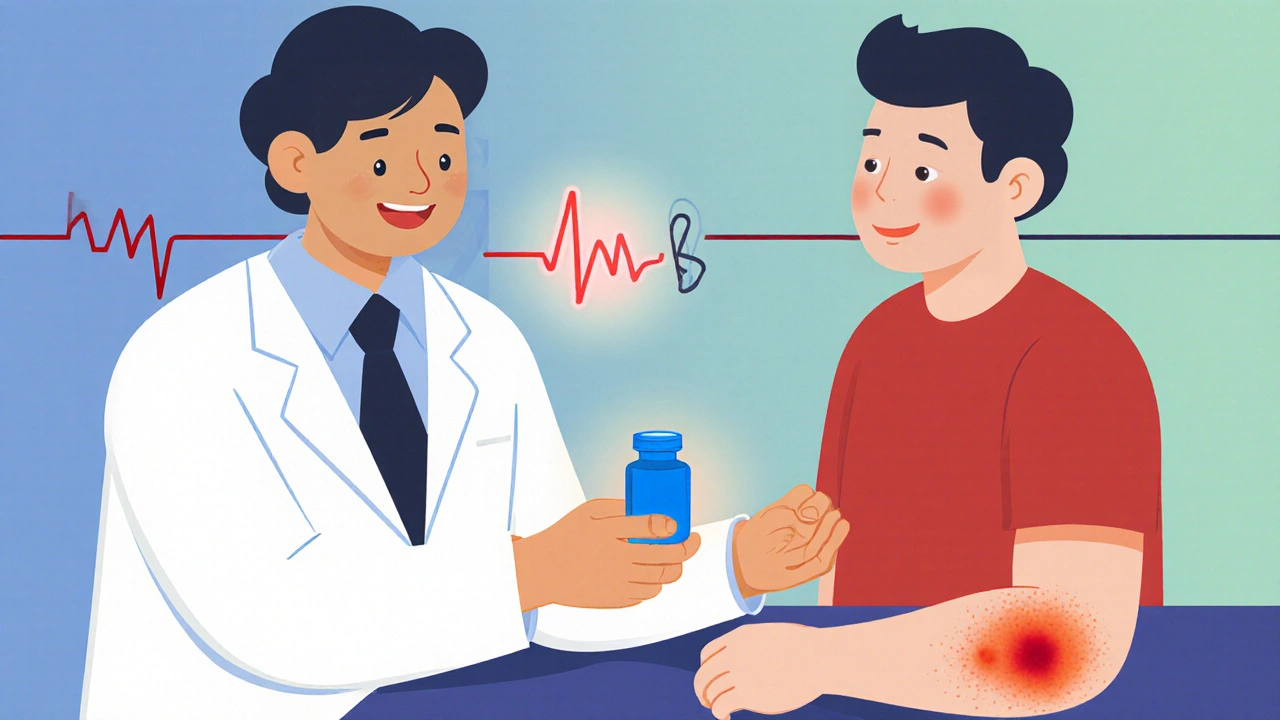Beta-Blocker Psoriasis Risk Calculator
When a prescription for high blood pressure or a heart rhythm problem arrives, most patients focus on the cardiovascular benefits and barely think about the skin. Yet a growing body of evidence shows that beta-blockers can light up psoriasis like a match in dry grass. If you or someone you know lives with psoriasis and has been put on a beta‑blocker, understanding the link, spotting the warning signs, and navigating treatment choices can make the difference between a manageable rash and a full‑blown flare.
What is Psoriasis?
Psoriasis is a chronic autoimmune condition that speeds up the growth cycle of skin cells, leading to dry, itchy, scaly plaques that can appear anywhere on the body. The National Psoriasis Foundation estimates that roughly 8.1 million Americans have the disease, and its severity ranges from a few isolated spots to extensive body‑covering eruptions. Triggers are numerous-stress, infections, climate, and, importantly, certain medications.
How Do Beta‑Blockers Work?
Beta‑blockers are a class of drugs that blunt the action of adrenaline on beta‑adrenergic receptors, slowing heart rate and lowering blood pressure. First introduced in the 1960s, they remain a mainstay for hypertension, angina, atrial fibrillation, and even migraine prophylaxis. Common agents include metoprolol, propranolol, atenolol, pindolol, and the topical eye drop timolol.
Evidence Linking Beta‑Blockers to Psoriasis Flares
Research over the past two decades paints a mixed but concerning picture. A 2022 DermNet NZ update reported that about 20 % of people with pre‑existing psoriasis experienced a flare after starting a beta‑blocker. Banner Health’s 2023 analysis singled out metoprolol as “one of the drugs most likely to cause psoriasis flares.” Conversely, a 2010 study (PMC2921739) found no strong correlation between cumulative beta‑blocker exposure and new‑onset psoriasiform lesions. The disparity likely stems from individual genetics, drug dosage, and latency periods that can stretch from one month up to 18 months.
Which Beta‑Blockers Carry the Highest Risk?
Not all beta‑blockers are created equal when it comes to skin reactions. The following table summarizes the agents most frequently cited in case reports and clinic surveys.
| Drug | Common brand names | Flare risk (observed) | Typical latency |
|---|---|---|---|
| Metoprolol | Lopressor, Toprol‑XL | High - 30 % of exposed psoriasis patients | 1-12 months |
| Propranolol | Inderal | Moderate - 20 % reported worsening | 2-18 months |
| Atenolol | Tenormin | Moderate - linked to pustular psoriasis in case reports | 3-15 months |
| Pindolol | Visken | Low‑to‑moderate - documented transformation to pustular type | 6-18 months |
| Timolol (topical) | Timoptic | Low - rare systemic absorption, but cases of erythroderma reported | Variable, often weeks |
These numbers aren’t precise prevalence rates; they reflect what clinicians and patients have reported in surveys, case series, and pharmacy databases.
How to Spot a Drug‑Triggered Flare
Because the latency can be long, many patients don’t associate a new or worsening rash with a medication started months earlier. Here are three red flags to keep on your radar:
- Sudden change in distribution: Plaques that were confined to elbows and knees suddenly appear on the trunk or scalp.
- Shift in morphology: A classic plaque turning into pustular lesions or, in rare cases, a widespread erythema that looks like a burn.
- Timing after medication change: Any noticeable skin shift within the first 1‑18 months after initiating a beta‑blocker should prompt a medication review.
When such patterns emerge, the standard protocol is a joint review by dermatology and cardiology. Stopping the suspected beta‑blocker (or switching to a different class) often leads to rapid improvement-sometimes within weeks.
Managing the Risk: Alternatives and Treatment Strategies
If a beta‑blocker is identified as the culprit, clinicians usually consider one of three routes:
- Switch to another antihypertensive: Calcium channel blockers (e.g., amlodipine) and angiotensin‑receptor blockers (ARBs) like losartan are widely used and have a lower documented skin‑related side‑effect profile.
- Try a cardio‑selective beta‑blocker: While propranolol is non‑selective, agents like atenolol preferentially block beta‑1 receptors. However, evidence suggests cross‑reactivity, so clinicians often avoid the class entirely for high‑risk psoriasis patients.
- Adjust dermatologic therapy: Topical corticosteroids, vitamin D analogues, or phototherapy can tame flares while the cardiovascular condition remains controlled.
Patient education is key. Because the flare may not appear until many months later, a written medication list with a note to monitor skin changes can help patients make the connection early.
Emerging Research and Future Directions
Genetic clues are emerging. A 2024 multicenter study (Johns Hopkins & Mayo Clinic) found that carriers of the HLA‑C*06:02 allele may be twice as likely to develop a beta‑blocker‑induced flare. If confirmed, a simple genetic test could guide prescribers toward safer blood‑pressure drugs for psoriasis patients.
Pharmaceutical innovators are also designing “beta‑1‑sparing” compounds that keep cardiac effects while sparing cutaneous beta‑adrenergic receptors. Early phase‑II trials report fewer skin complaints, but these agents are still years away from market approval.
On the diagnostic front, dermatologists are now asked to document medication history as a standard element of every new psoriasis visit, per the 2023 European Academy of Dermatology and Venereology consensus. This systematic approach improves detection and reduces unnecessary drug discontinuations.
Take‑Home Checklist for Patients and Clinicians
- Ask every psoriasis patient about current beta‑blocker use, including eye‑drop formulations.
- Consider a trial withdrawal or switch if a flare starts within 1‑18 months of starting the drug.
- Prefer calcium channel blockers or ARBs for hypertension in patients with active psoriasis.
- Educate patients to watch for new plaques, pustules, or sudden spread of existing lesions.
- Stay tuned for genetic testing that may predict susceptibility.
Can beta‑blockers cause psoriasis in people who have never had it?
The evidence is mixed. Some studies show a modest increase in new‑onset psoriasis, especially with high‑dose metoprolol, but most data point to worsening of pre‑existing disease rather than creating it from scratch.

If I stop my beta‑blocker, will my skin improve right away?
Often, yes. Many patients notice a reduction in redness and scaling within 2‑4 weeks after discontinuation, though severe cases may need additional dermatologic treatment.
Are all beta‑blockers equally risky for psoriasis?
No. Non‑selective agents like propranolol and metoprolol have the most reports, while highly cardio‑selective drugs such as bisoprolol appear less frequently, though cross‑reactivity still exists.
What alternatives can I discuss with my doctor?
Calcium channel blockers (amlodipine, diltiazem) and ARBs (losartan, valsartan) are widely used for hypertension and have far fewer skin‑related side effects. Your cardiologist can help choose the best fit.
Should I get genetic testing for HLA‑C*06:02?
At present, testing is not routine and is usually limited to research settings. Talk to your dermatologist if you have a strong family history of drug‑triggered psoriasis.



Hershel Lilly
Beta‑blockers can indeed set off a psoriasis flare in susceptible patients.
October 26, 2025 AT 11:46
Carla Smalls
It’s worth keeping a close eye on any new or worsening patches after starting a beta‑blocker.
Even a modest increase in redness can be a warning sign that the medication is kicking off the immune cascade.
Coordinating with both a dermatologist and a cardiologist often smooths the path to a safer alternative.
Patients who log their skin changes alongside medication dates tend to spot the pattern sooner.
Overall, proactive monitoring makes the difference between a brief irritation and a chronic flare.
October 27, 2025 AT 01:39
Monika Pardon
The notion that a cardiovascular drug could meddle with epidermal turnover is, frankly, a textbook illustration of pharmacological off‑target effects.
When beta‑adrenergic receptors are blocked systemically, the downstream signaling that normally tempers keratinocyte proliferation can become dysregulated.
This dysregulation is particularly pronounced in individuals who already harbor the HLA‑C*06:02 allele, a genetic marker that predisposes to exaggerated immune responses.
Clinical reports have repeatedly noted that metoprolol, among the most prescribed agents, appears at the top of the adverse‑event tables for psoriasis exacerbation.
Yet the data are anything but uniform, with some studies failing to demonstrate a statistically significant correlation.
The heterogeneity likely stems from variations in dosage, patient age, and the latency period that can span weeks to many months.
Moreover, the non‑selective nature of propranolol introduces an additional variable, as it influences both beta‑1 and beta‑2 receptors across multiple tissues.
In practice, physicians often resort to a trial discontinuation to gauge improvement, which, if successful, lends credence to causality.
One must also consider the psychosocial impact of a sudden skin outbreak, which can erode adherence to essential cardiac therapy.
From a mechanistic standpoint, the reduction in cyclic AMP levels consequent to beta‑blockade may diminish the anti‑inflammatory pathways that keep psoriasis in check.
Conversely, certain topical beta‑blocker formulations, such as timolol eye drops, have been implicated in rare systemic reactions despite minimal absorption.
The specter of pustular transformation, although uncommon, further complicates the risk‑benefit calculus for high‑risk patients.
Emerging pharmacogenomic screening holds promise for pre‑emptively identifying those who should avoid this class altogether.
Until such testing becomes routine, clinicians must rely on detailed medication histories and vigilant skin examinations.
In short, the relationship is a nuanced dance between drug pharmacodynamics and individual immunogenetics.
Therefore, a judicious, patient‑centered approach remains the cornerstone of safe prescribing.
October 28, 2025 AT 05:26
Laura Hibbard
Sure, swapping out a beta‑blocker for a calcium channel blocker is as simple as changing socks, but it does spare the skin from an unwanted fireworks display.
Just make sure your cardiologist is in the loop; otherwise, you might end up with a heart that’s as jittery as your rash.
October 29, 2025 AT 23:06
Jacqui Bryant
Keep an eye on any new patches and tell your doctor right away – early action can keep the flare from taking over.
November 1, 2025 AT 06:39
Lori Brown
Exactly! A quick note to your doctor can save you weeks of itch and discomfort :)
November 4, 2025 AT 04:06
Manoj Kumar
One could argue that the universe delights in reminding us that every solution carries its own hidden paradox, like a beta‑blocker that steadies the pulse yet unsettles the skin.
In the grand tapestry of medicine, we are merely stitching threads that sometimes tangle in the most unexpected patterns.
Thus, embracing the irony becomes a form of enlightened acceptance.
November 7, 2025 AT 15:26
Brady Johnson
The drama of it all is almost theatrical – imagine a drug, hailed as a hero for hearts, stepping into the spotlight as the villain of the skin, eliciting eruptions that blaze like fury on a calm stage.
November 11, 2025 AT 16:39
Jay Campbell
Documenting all meds during each dermatology visit is now standard practice, reducing missed drug‑induced flares.
November 16, 2025 AT 07:46
Rachel Zack
Totlly agree, but also make sure the doctors ask about eye‑drop beta‑blockers too-those little bottles can slip through the cracks.
November 21, 2025 AT 12:46